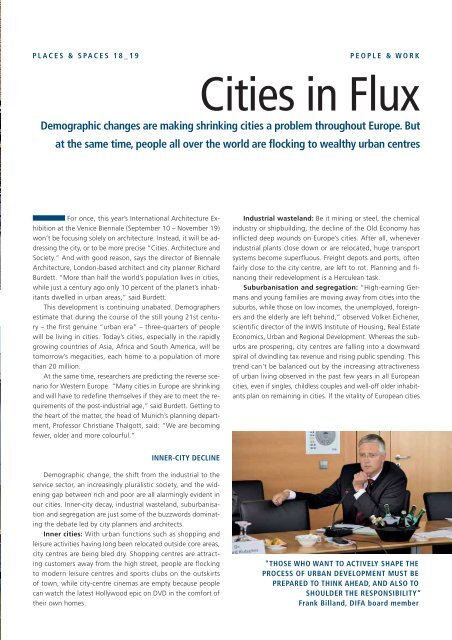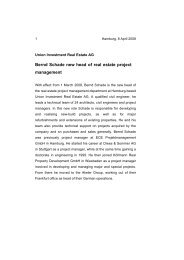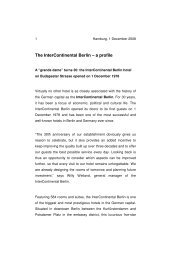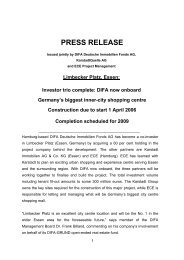BREAKTHROUGH IN THE CITY Why London's ... - Union Investment
BREAKTHROUGH IN THE CITY Why London's ... - Union Investment
BREAKTHROUGH IN THE CITY Why London's ... - Union Investment
Create successful ePaper yourself
Turn your PDF publications into a flip-book with our unique Google optimized e-Paper software.
PLACES & SPACES 18_19 PEOPLE & WORK<br />
Cities in Flux<br />
Demographic changes are making shrinking cities a problem throughout Europe. But<br />
at the same time, people all over the world are flocking to wealthy urban centres<br />
For once, this year’s International Architecture Exhibition<br />
at the Venice Biennale (September 10 – November 19)<br />
won’t be focusing solely on architecture. Instead, it will be addressing<br />
the city, or to be more precise “Cities. Architecture and<br />
Society.” And with good reason, says the director of Biennale<br />
Architecture, London-based architect and city planner Richard<br />
Burdett. “More than half the world’s population lives in cities,<br />
while just a century ago only 10 percent of the planet’s inhabitants<br />
dwelled in urban areas,” said Burdett.<br />
This development is continuing unabated. Demographers<br />
estimate that during the course of the still young 21st century<br />
– the first genuine “urban era” – three-quarters of people<br />
will be living in cities. Today’s cities, especially in the rapidly<br />
growing countries of Asia, Africa and South America, will be<br />
tomorrow’s megacities, each home to a population of more<br />
than 20 million.<br />
At the same time, researchers are predicting the reverse scenario<br />
for Western Europe. “Many cities in Europe are shrinking<br />
and will have to redefine themselves if they are to meet the requirements<br />
of the post-industrial age,” said Burdett. Getting to<br />
the heart of the matter, the head of Munich’s planning department,<br />
Professor Christiane Thalgott, said: “We are becoming<br />
fewer, older and more colourful.”<br />
<strong>IN</strong>NER-<strong>CITY</strong> DECL<strong>IN</strong>E<br />
Demographic change, the shift from the industrial to the<br />
service sector, an increasingly pluralistic society, and the widening<br />
gap between rich and poor are all alarmingly evident in<br />
our cities. Inner-city decay, industrial wasteland, suburbanisation<br />
and segregation are just some of the buzzwords dominating<br />
the debate led by city planners and architects.<br />
Inner cities: With urban functions such as shopping and<br />
leisure activities having long been relocated outside core areas,<br />
city centres are being bled dry. Shopping centres are attracting<br />
customers away from the high street, people are flocking<br />
to modern leisure centres and sports clubs on the outskirts<br />
of town, while city-centre cinemas are empty because people<br />
can watch the latest Hollywood epic on DVD in the comfort of<br />
their own homes.<br />
Industrial wasteland: Be it mining or steel, the chemical<br />
industry or shipbuilding, the decline of the Old Economy has<br />
inflicted deep wounds on Europe’s cities. After all, whenever<br />
industrial plants close down or are relocated, huge transport<br />
systems become superfluous. Freight depots and ports, often<br />
fairly close to the city centre, are left to rot. Planning and financing<br />
their redevelopment is a Herculean task.<br />
Suburbanisation and segregation: “High-earning Germans<br />
and young families are moving away from cities into the<br />
suburbs, while those on low incomes, the unemployed, foreigners<br />
and the elderly are left behind,” observed Volker Eichener,<br />
scientific director of the InWIS Institute of Housing, Real Estate<br />
Economics, Urban and Regional Development. Whereas the suburbs<br />
are prospering, city centres are falling into a downward<br />
spiral of dwindling tax revenue and rising public spending. This<br />
trend can’t be balanced out by the increasing attractiveness<br />
of urban living observed in the past few years in all European<br />
cities, even if singles, childless couples and well-off older inhabitants<br />
plan on remaining in cities. If the vitality of European cities<br />
"THOSE WHO WANT TO ACTIVELY SHAPE <strong>THE</strong><br />
PROCESS OF URBAN DEVELOPMENT MUST BE<br />
PREPARED TO TH<strong>IN</strong>K AHEAD, AND ALSO TO<br />
SHOULDER <strong>THE</strong> RESPONSIBILITY“<br />
Frank Billand, DIFA board member









